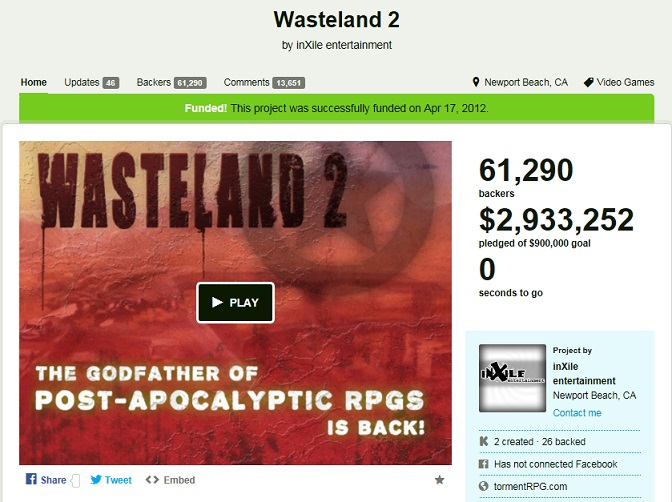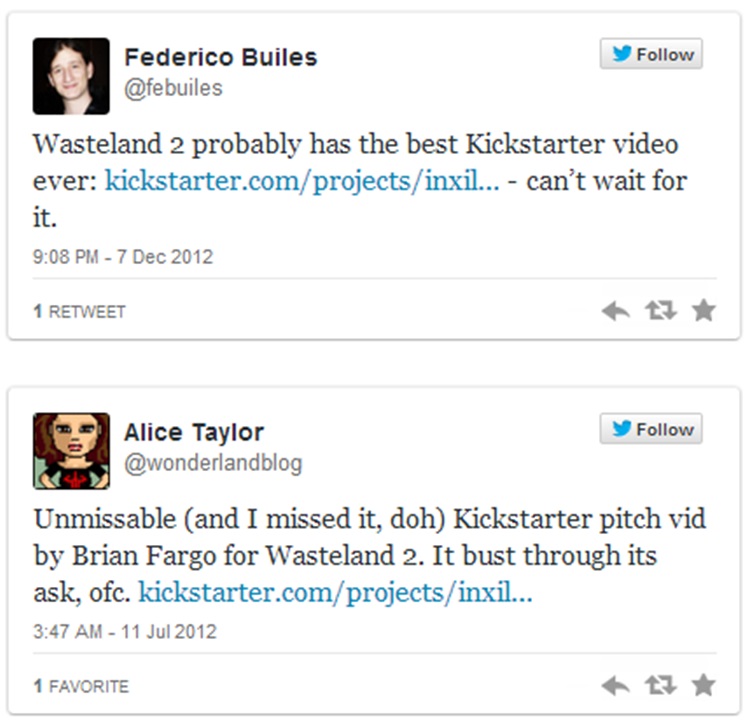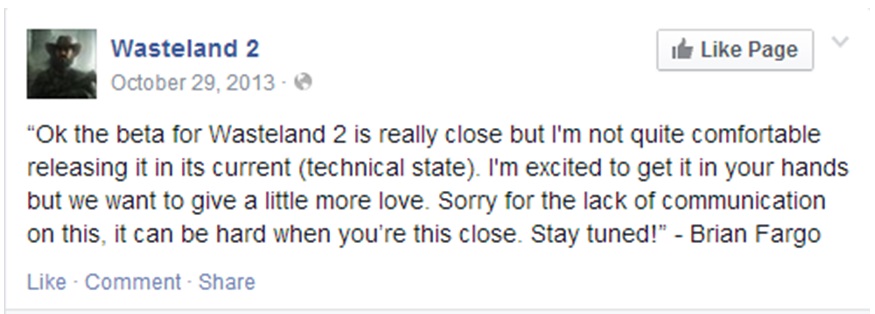Campaign Postmortem: Wasteland 2
By Brad Jones
(Click here for our Early Access review of Wasteland 2 the game.)
[divider] [dropcap]W[/dropcap]hen the Kickstarter for Wasteland 2 began, it seemed to many that the lofty funding goal of $900,000 to make a sequel to a hardcore 1988 WRPG was very ambitious, if not completely unattainable. Whilst we know now that the campaign was a massive success—even today, it ranks as the seventh most successful crowdfunding campaign for a video game—it’s important to remember that, on the face of it, the campaign looked to have a good chance of failing.The comments above, taken from the NeoGAF thread discussing the launch of the Kickstarter, sum up some of the more pessimistic or realistic voices mixed in with the more hopeful crowd. Crucially, even those that were dismissive of whether the project would reach its goal still felt that it should reach said goal, in a perfect world. The project had already garnered the backing of the gaming community, and this ‘hearts and minds’ approach would certainly prove worthwhile for inXile in the long run.
One element to this approach that would perhaps prove to be crucial in the early going is the fact that inXile announced its plans well ahead of time, nearly a month before the Kickstarter itself would go live. Whilst it’s not unusual at all for a successful Kickstarter to have a decent first day followed by a strong second when news of the campaign has begun to circulate, the campaign for Wasteland 2 had $470,575 in its coffers from over 8000 backers by the end of its first day. Is the news of a surprise campaign sure to spread over the internet very quickly? Yes, but the Wasteland 2 campaign proves that you don’t need the element of surprise to run a successful campaign, you just need to be willing to do things properly.
On a side note, reading through the NeoGAF thread through the first few hours as things turn from rather dour to begin with to really rather jubilant as the money starts pouring in is well worth doing. One user called ‘subversus’ makes the almost outlandish prediction that the campaign will bring in $150,000-$250,000 in the first day but is soon proven to be underestimating rather than overestimating. It’s nice to see fans of the original game scoring on the outside chance that they’d ever receive a sequel.
So what was the campaign doing so right? Well, for starters, it’s an attractive product. Fans of the 1988 original are likely in the sort of financial position where they can find the money to shell out for the bells and whistles of the more expensive backer tiers, but the $15 price point for a digital download of the game sounds like a steal for someone who perhaps isn’t as familiar with the series. That being said, there was the opinion (and it can be seen in the discussion thread on NeoGAF) that the $15 price point meant that this would not be a big-budget production and perhaps closer to the sort of budget downloadable title you’d get on XBLA and the like. Wasteland 2 has now been released as a beta version via Steam Early Access and as anyone who has spent some time with it with likely attest to, it certainly has all the scope of a full retail title, so this just goes to show how important pricing is to how your product is looked upon, even on Kickstarter.
A slick pitch video is obviously crucial to the success of just about any crowdfunding campaign, and whilst for me the effort that launched Wasteland 2 on Kickstarter was a little hokey, it seems that I am in the minority.
The pitch video in question is funny and to the point, which I suppose are better ways of getting to your audience than glossy production values. Of course, it doesn’t hurt that front and centre in the video—and the campaign in general—is Brian Fargo, who is about as ideal a face for the project as could be. Fargo is a veteran of the video game industry who comes off as intelligent and passionate, and is integral to the narrative that surrounded the Wasteland 2 Kickstarter campaign.
The above quote from a Reddit AMA cuts to the core of that narrative; that crowdfunding wrests control of the product from suits, and puts it back in the hands of creators and audiences. Brian Fargo is, rather unsurprisingly given the success that inXile have enjoyed with service, a Kickstarter evangelist. The ‘Kicking it Forward’ program established by inXile to pass on some of their good fortune onto others pursuing crowdfunding is concrete evidence of this. As such, his passion for both the game he was working on and the method of financing it made crowdfunding seem like the ideal method of funding the development of a video game. Whether or not this is the case in truth—and it is still up for debate—the freshness of crowdfunding at the time of this campaign certainly had a hand in its enormous success.
That being said, nothing should be taken away from just how well-run this campaign was for its duration. One example of this is the near-perfect execution of a strategy to keep money flowing in after the initial funding goal was reached very quickly.
As you can see, the project was funded before it was even three days old. Obviously, on the surface this is an ideal situation—but there is the possibility that it could lead to money being left on the table. If the project is funded already, the Kickstarter campaign loses one key aspect to its appeal; backers no longer feel like they are ‘supporting’ a project, in that the work has already been done and they are once again just a consumer buying a product. Stretch goals are the main way of alleviating this situation, but all too often they can seem rather trivial compared to the initial funding goal. However, for Wasteland 2, inXile pulled out all the stops with an announcement on the 30th of April that if the project could hit $1.5 million in pledges, fellow RPG phenom Obsidian would assist with development.
Looking at the graph above shows quite neatly just how well this strategy worked. A sizeable boost in pledges can be seen on the 30th, as well as on the 5th of April when the project did indeed hit $1.5 million in pledges. In between these two dates you can also see a marked increase in pledges compared to the days leading up to the announcement, and this increased support carried on into the always-bountiful home stretch. Wasteland 2 was suffering from the sort of mid-campaign malaise that can be observed in just about every crowdfunded project. The beginning and the end are always very exciting, but it’s difficult to keep people engaged for the comparatively uneventful middle period—but this effective stretch goal did just that.
You may think from all this that the crowdfunding campaign for Wasteland 2 went off without a hitch, but you’d be wrong. One of the key elements to the whole thing was the promise that a beta version of the game would be made available for backers at a certain pledge tier, and in a fairly typical scene from video game development, this product missed its date.
Brian Fargo released the above statement in relation to this delay, and it soon spread across the many social media portals and other websites that Wasteland fans and backers would typically frequent. Free from the sort of jargon and doublespeak that the video game press release is typically plagued with, Fargo gave his audience a frank summation of what was going on. It’s exactly the way that a fan would expect to be treated having put up money for a product that doesn’t yet exist in backing that product on Kickstarter.
[divider] [dropcap]W[/dropcap]hy was the crowdfunding campaign for Wasteland 2 so successful? The people behind it—including but not limited to Brian Fargo himself—have a deep understanding of what crowdfunding is, who their audience are and how those two things relate. From that point on, it was all in the execution.This campaign started out in fine form because everyone who needed to know was well aware when it was set to start. Then, when the initial rush of backers started to taper off, inXile released word of their partnership with Obsidian and once again set pulses racing about the project. Brian Fargo did his part as a spokesman for the game very well, keeping in touch with fans at every stage and speaking frankly and honestly about what was going on. However, all this would have been for nothing if the game hadn’t been something that fans wanted and the studio could deliver on. Wasteland 2 is a great game, and that will go a long way to make a crowdfunding campaign successful—the way this campaign in particular got so successful was by having a great product and still making sure to do everything else just right.
[divider]You can learn more about Wasteland 2 by checking out our review of the Wasteland 2 Early Access.
[Google][pinterest][follow id=”Cliqist” size=”large” count=”true” ] [author image=”http://cliqist.com/wp-content/uploads/2014/01/brad1.jpg”]Brad Jones is a Yorkshire-born writer currently spending his time in Scotland and the Northeastern United States in roughly even measure. He likes to write about things like genre movies, pro wrestling and video games. You know, the stuff that will be considered fine art in thirty years but no one gives the time of day just now. You can find Brad on Twitter under the handle @radjonze. [/author]













[…] You can read more of our Campaign Postmortems right here. […]